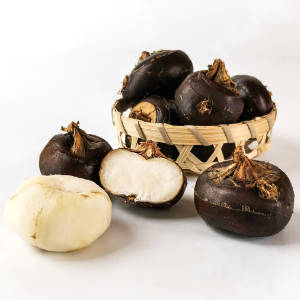All Ingredients
Viognier
This assertive white wine from California exudes a complex perfume of flowers and fruit. It's expensive and hard to find, but it's delicious with seafood and poultry.
Learn morevodka
This flavorless, colorless liquor is a great mixer, since it blends unobtrusively with other ingredients. Some prefer to drink it straight, poured from bottles they store in the freezer. Since vodka is virtually flavorless, the differences between the brands are all but imperceptible to the mortal tongue. Buy the cheapest brand if you're using the vodka in mixed drinks. Flavored vodkas also are available; here the differences in quality may be more noticeable.
Learn moreWakame
This has a sweet flavor, and it's rich in calcium. It's often rehydrated and then added to miso soup or sautéed as a side dish. Dry wakame can also be toasted and crumbled over salads and other dishes. It's very high in calcium.
Learn morewalnut
Walnuts are rich and flavorful, and cooks like to use them in everything from fudge to salads. Markets usually carry English walnuts = royal walnuts = Persian walnuts. Less common are black walnuts, which are much more flavorful but harder to shell. To roast, put shelled walnuts on a baking pan and in bake them in a 325° oven, stirring occasionally, until they're slightly golden, about ten minutes. After you remove the nuts from the oven, rub them vigorously with a towel so as to remove as much of their bitter skins as possible. Fresh walnuts are available year-round, but they're best in the fall. Since they're high in fat and therefore prone to rancidity, it's best to store them in the refrigerator or freezer.
Learn morewashed-rind cheese
As they ripen, these cheeses are washed with a liquid. The moisture encourages the growth of bacteria, giving the cheese a strong odor and flavor. Many of these cheeses are soft or semi-soft and have sticky, reddish-orange rinds, which most people consider too pungent to eat. It takes a strong wine like a Burgundy or Pinot Gris to stand up to most of the cheeses in this category. Beer works, too. This category includes Limburger, Muenster, Maroilles, Langres, Epoisses, Tallegio, Abondance, Urgelia, Epoisses, Pont l'Evêque, Mahon, Reblochon, Port Salut, and Livarot.
Learn morewater caltrop
This black nut bears an unmistakable resemblance to a bull's head. Each one is about two inches across, and has a very hard shell. After you shell water caltrops, you'll need to steam or boil them before you can eat them as they contain harmful toxins in their raw state. Or you can skip eating them altogether, and just use them to make jewelry.
Learn morewater chestnut
Water chestnuts are delightfully sweet and crisp--if you buy them fresh. Though canned water chestnuts are more easily available, they're not nearly as good. Look for fresh water chestnuts in Asian markets. You need to peel off their brown jackets and simmer them for five minutes before stir-frying. If you must use canned water chestnuts, blanch them first in boiling water for thirty seconds.
Learn morewater chestnut starch
Asian cooks often dredge foods in this before frying them, because it gives fried foods a crisp, nutty coating. It can also be used as a thickener. Look for it in Asian markets and health food stores. Don't confuse this with chestnut flour.
Learn morewater cracker
These crunchy crackers have little flavor, making them a neutral foundation for spreads and appetizers.
Learn morewater spinach
This cooking green is very common in the Philippines. Some varieties have purple stems.
Learn morewatermelon
There are about 50 varieties of watermelon on the market. They all taste about the same, but they vary in size, flesh color, and in whether they are seeded or seedless. Picnic melons are largest, while icebox melons are round and compact. Many stores also carry yellow-fleshed, white-fleshed, and seedless melons. The rind should be heavy for its size, and free of bruises, soft spots, or cuts. To check for ripeness, look at the pale side of the melon (where it rested while it was growing)--it should be yellow, not white. If your market sells halved watermelons, inspect the flesh--it should be firm, brightly colored, and free of white streaks. Seeded watermelons should have dark brown or black seeds. To store, wrap watermelon slices loosely in plastic and refrigerate for up to two days. Uncut watermelon can be stored at room temperature (preferably in a cool spot) for up to two weeks.
Learn morewatermelon seeds
These are much larger than the black watermelon seeds that we're familiar with. They're usually cracked open and eaten like sunflower seeds. Look for them in Middle Eastern markets.
Learn morewax bean
These are similar to green beans except for the color, which can be yellow or purple. Don't confuse these with lima beans, which are sometimes called wax beans.
Learn morewax paper
Invented by Thomas Edison, this is paper that's coated with paraffin wax to make it resistant to moisture. To use wax paper as a cake pan liner, place the pan on the paper, trace its outline, then cut it out and place it in the pan.
Learn moreweisswurst
These are mildly seasoned German veal sausages, very light in color. Germans like to eat them with potato salad during Oktoberfest. Cook before eating.
Learn moreWensleydale
This is a fairly mild English cheese. It was originally made from sheep's milk but is now made from cow's milk.
Learn moreWestphalian ham
This choice German ham is smoked over beechwood and juniper and has a salty, smoky flavor. It's usually cut into very thin slices and eaten raw.
Learn morewheat
Wheat's got a pleasant, nutty flavor and lots of nutrients, but it's prized most for being rich in gluten, the stuff that makes baked goods rise. Most wheat is ground into flour, but whole or cracked grains are used in pilafs and salads, and wheat flakes are made into hot cereals or granolas.
Learn morewheat berries
These are wheat kernels that have been stripped only of their inedible outer hulls. They're nutritious, but they take hours to cook. If you don't have the patience to use the whole berries, try the more convenient cracked wheat, bulgur, or wheat flakes.
Learn more







































































































































































































































































































































































